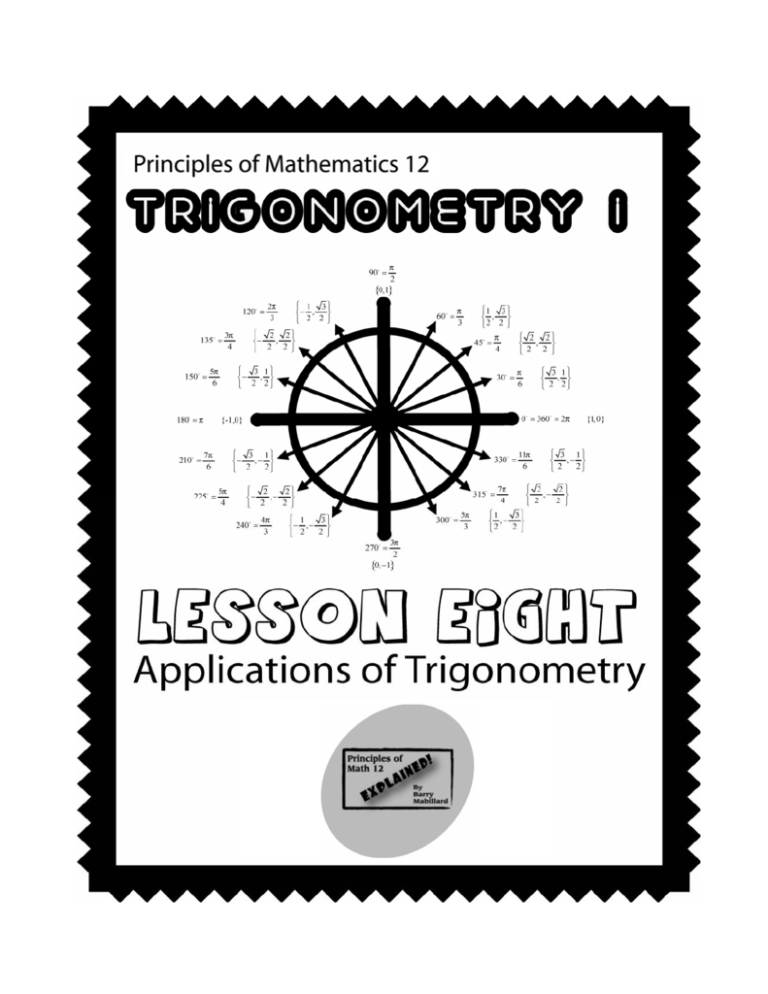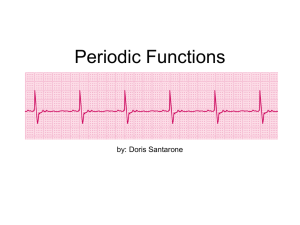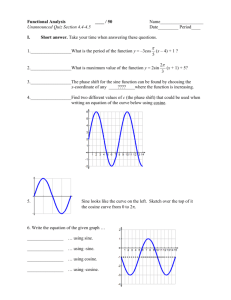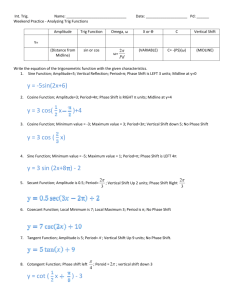Trigonometry Applications: Ferris Wheels & Year Questions
advertisement

Principles of Mathematics 12: Explained! www.math12.com 185 Trigonometry Lesson 8: Part I – Ferris Wheels One of the most common application questions for graphing trigonometric functions involves Ferris wheels, since the up and down motion of a rider follows the shape of a sine or cosine graph. Example: A Ferris wheel has a diameter of 30 m, with the centre 18 m above the ground. It makes one complete rotation every 60 s. a) Draw the graph of one complete cycle, assuming the rider starts at the lowest point. b) Find the cosine equation of the graph. c) What is the height of the rider at 52 seconds? d) At what time(s) is the rider at 20 m? ---------------------------------------------------------------a. When you look at a Ferris wheel it 35 Midline at 18 m 30 Height (m) makes a circular motion. Do NOT draw a circle as your graph. The graph represents the up & down motion over time. In the first half of the graph, we can see the person will go up from 3 m to 33 m in 30 seconds. In the second half, the person will go back down to 3 m. 25 20 15 10 5 b. a-value: We know the diameter of the wheel is 30 m, so the radius (which is the same as amplitude) will be 15 m. 2π 2π π = = P 60 30 time in either the cosine equation. Simplify and calculate with your TI-83 in radian mode π h(t ) = −15cos t + 18 30 π h(52) = −15cos 52 + 18 30 h(52) = 7.96 m pattern. d-value: The centre of the wheel is 18 m above the ground, so that will be the midline The cosine pattern is upside down, so you need to put a negative in front. π 30 30 40 50 60 Time (s) c-value: There is none in the cosine h(t) = -15cos 20 c. Method 1: Plug 52 s in for b-value: The period is 60 s, so: b= 10 d. Method 2: Put your calculator in radian mode and graph either the cosine function. 2nd Trace Æ Value Æ x = 52 This will calculate the height directly from the graph. To find the times the rider is at 20 m, graph a horizontal line in your TI-83 at y = 20, then find the points of intersection. t +18 The rider has a height of 20 m at 16.3 s and 43.7 s Principles of Mathematics 12: Explained! www.math12.com 186 Trigonometry Lesson 8: Part I – Ferris Wheels In some Ferris wheel questions, you will be given the rotational speed in units of revolutions per second or revolutions per minute. You can use these values to find the period as follows: Example: A Ferris wheel rotates at 4 rev/min. What is the period in minutes & seconds? Think of it this way: there are 60 seconds in a minute. If it completes four revolutions, each one must take only 15 seconds. Thus, the period is 15 s. Conversion Reminder: Minutes Æ Seconds: Multiply by 60 Seconds Æ Minutes: Divide by 60 Ferris Wheel Questions --------------------------------------------------------------1. A Ferris wheel has a radius of 35 m and starts 2 m above the ground. It rotates once every 53 seconds. a) Determine the cosine equation of the graph, if the rider gets on at the lowest point. b) Sketch two complete cycles of a graph representing the height of a rider above the ground, assuming the rider gets on the Ferris wheel at the lowest point. c) What is the height of the rider at 81 seconds? d) At what time does the rider first reach a height of 51 m? 2. A Ferris wheel makes 4 revolutions in one minute. The diameter of the Ferris wheel is 28 m, and a rider boards from a platform at a height of 30 m above the ground. The ride lasts 30 seconds. a) Determine the cosine equation. (Hint: Think about where the rider is starting in this question.) b) Sketch the graph for the complete ride. c) At what times is the rider at a height of 20 m? Principles of Mathematics 12: Explained! www.math12.com 187 Trigonometry Lesson 8: Part I – Ferris Wheels 3. A water wheel on a paddleboat has a radius of 1 m. The wheel rotates once every 1.46 seconds and the bottom 0.3 m of the wheel is submerged in water. (Consider the water surface to be the x-axis) a) Determine the cosine equation of the graph, starting from a point at the top of the wheel. b) Graph the height of a point on the wheel relative to the surface of the water, starting from the highest point. c) How long is a point on the wheel underwater? 4. The bottom of a windmill is 8 m above the ground, and the top is 22 m above the ground. The wheel rotates once every five seconds. a) Determine the cosine equation of the graph, starting from a point at the bottom of the windmill. b) Draw the graph of two complete cycles. c) What is the height of the point after 4 seconds? d) For how long (over the course of both cycles) is the point above 17 m? 5. A point on an industrial flywheel experiences a motion described by the formula: h(t) = 13cos 2π t +15 0.7 a) What is the maximum height of the point? b) At what time is the maximum height reached? c) What is the minimum height of the point? d) At what time is the minimum height reached? e) How long, within one cycle, is the point lower than 6 m above the ground? f) What is the height of the point if the wheel turns for 2 hours and 20 minutes? Principles of Mathematics 12: Explained! www.math12.com 188 Trigonometry Lesson 8: Part I – Ferris Wheel ANSWERS 1. a) a-value: The amplitude is 35 (upside down since the rider gets on at the bottom, so use a negative in the equation b-value: b = 2π = 2π P 53 c) ) c-value: None for cosine d-value: The lowest point is 2 m off the ground and the radius is 35 m, so the midline will be at 37 m. h(t ) = −35 cos b) To find the height at 81 seconds, plug the time into the equation. 2π t + 37 53 2π h (81) = − 35 cos (81) + 37 53 h (81) = 71.4 h (t ) = − 35 cos Or use the simpler method of 2nd Æ Trace Æ Value Æ x = 81 2π t + 37 53 d) 70 In your TI-83, graph the equation and also the line y = 51. The first intersection point will give the time the height first reaches 51 m. Height (m) 60 50 40 30 20 10 20 40 60 80 100 51 m is first reached at 16.7 s Time (s) ---------------------------------------------------------------- 2. a) The diameter is 28 m, so the radius is 14. The period is 15 seconds. a-value: The amplitude is 14 b-value: b= 2π 2π = P 15 c-value: None for cosine d-value: The highest point is 30 m off the ground and the c) radius is 14 m, so the midline will be at 16 m. 2π t + 16 15 *Use a positive since the rider gets on at the top, and therefore the cosine graph is upright. h(t ) = 14 cos Height (m) b) 30 25 The rider is at a height of 20 m at the following times: 3.06 s 11.9 s 18.1 s 26.9 s 20 15 10 5 5 10 15 20 25 30 Time (s) Principles of Mathematics 12: Explained! www.math12.com 189 Trigonometry Lesson 8: Part I – Ferris Wheel ANSWERS b) The period is 1.46 seconds a-value: The amplitude is 1. b-value: c-value: For the cosine graph, there is none. d-value: The midline will be at 0.7 m, since the bottom is at -0.3 m and the radius is 1 m. h(t ) = cos 2 1.5 2π 2π = b= P 1.46 2π t + 0.7 1.46 Height (m) 3. a) 1 0.5 0.2 -0.5 0.4 0.6 0.8 1 1.2 1.4 Time (s) c) Use your TI-83 to find the points of intersection with the line y=0. (In this case, it’s the same as the x-intercepts) The point on the wheel is first submerged at 0.545 s, and exits the water at 0.915 s. The total time underwater is 0.37 s. --------------------------------------------------------------- 4. a) The period is 5 seconds. c) a-value: The amplitude is 7. To find the height at 4 seconds, plug the time into your equation. c-value: For the cosine graph, there is none. 2π t + 15 5 2π h(4) = −7 cos (4) + 15 5 h(4) = 12.8m d-value: The midline is at 15. Or, use 2nd Æ Trace Æ Value Æ x = 4 max − min 22 − 8 14 = = =7 2 2 2 2π 2π b= = 5 P h(t ) = −7 cos amplitude = b-value: max + min 22 + 8 30 midline = = = = 15 2 2 2 2π h(t ) = −7 cos t + 15 5 The cosine pattern is upside down, so we need a negative. Height (m) b) d) 25 In the first cycle, the point is above 17 m between 1.48 s and 3.52 s, for a total of 2.04 seconds. Since the second cycle is identical to the first, the total time spent above 17 m is 4.08 s. 20 15 10 5 2 4 6 8 10 Time (s) Principles of Mathematics 12: Explained! www.math12.com 190 Trigonometry Lesson 8: Part I – Ferris Wheel ANSWERS 30 5. a) The midline is at 15 m, and the radius is 13 m, so the maximum height is 28 m. b) The maximum occurs at the beginning of the cycle (0 s) and the end (0.7 s) c) The midline is at 15 m, and the radius is 13 m, so the minimum height is 2 m. d) the minimum is reached exactly Height (m) 25 20 15 10 5 halfway, so 0.35 s. 0.1 0.2 0.3 0.4 0.5 0.6 0.7 Time (s) e) The point first goes under 6 m at 0.26 s, and then rises above at 0.44 s. The total time then is 0.18 s. f) We need to convert the time to seconds. 2 hours and 20 minutes is 140 min. 140 min = 8400 s. 2π t + 15 0.7 2π h(8400) = 13cos (8400) + 15 0.7 h(8400) = 28 h(t ) = 13cos Principles of Mathematics 12: Explained! www.math12.com 191 Trigonometry Lesson 8: Part II – Year Questions Events that are cyclic, such as seasonal variations in temperature, can be modeled with trigonometric functions. Example: The average temperature for Regina is hottest at 27 ºC on July 28, and coolest at -16 ºC on January 10. a) Write the cosine equation for the graph. b) Draw the graph that approximates the temperature curve for the year. c) What is the average temperature expected for October 4? d) The average temperature is higher than 23 ºC for how many days? --------------------------------------------------------------a) Whenever there are questions that deal with values over c) To find the expected temperature on October 4, an entire year, the period is 365. first find what day of the year it is. a-value: The amplitude is 21. 31+28+31+30+31+30+31+31+30+4 = 277 max − min 27 − (−16) 43 = = = 21.5 2 2 2 2π 2π = b= P 365 amplitude = b-value: c-value: We are starting the graph on January 1, so that is day zero. The maximum value (where the positive cosine graph would begin) is on July 28. So, the number of days to July 28 is: 31+28+31+30+31+30+28 = 209 Now use this in your equation: 2π (d − 209) + 5.5 365 2π T (277) = 21.5cos (277 − 209) + 5.5 365 T (277) = 13.9 T (d ) = 21.5cos Or, graph in your TI-83 and type: 2nd Æ Trace Æ Value Æ x = 277 d-value: The midline is at 5.5. midline = max + min 27 + (−16) 11 = = = 5.5 2 2 2 T (d ) = 21.5cos d) 2π (d − 209) + 5.5 365 Where T is temperature in ºC, and d is the number of days. Temperature (ºC) b) 30 20 Use your TI-83 to find the intersection points of the graph and the line y=23. 10 50 100 150 200 250 -10 300 350 The first day over 23 ºC is day 173. The last day over 23 ºC is day 245. The total time is 72 days. -20 -30 Time (days) Principles of Mathematics 12: Explained! www.math12.com 192 Trigonometry Lesson 8: Part II – Year Questions Example 2: The earliest sunset occurs at 5:34 PM on Dec. 21, and the latest at 11:45 PM on June 21. a) Write the cosine equation of the graph. b) Draw the graph approximating the sunrise times throughout the year. c) What is the sunset time on April. 6? d) The sunset time is earlier than 8 PM for what percentage of the year? --------------------------------------------------------------hour/minute form when creating an equation! Convert to decimal hour form. Conversion Reminder: To get the hours, think of the 24-hour clock. Then divide the number of minutes by 60 to finish off the decimal. b) Time (hours) a) Before anything else, we are never allowed to use time in 5:34 PM Æ 5 PM is 17 hours on the 24-hour clock. Then, 11/60 = 0.57. So, the time we use is 17.57 11:45 PM Æ 11 PM is 23 hours on the 24-hour clock. Then, 45/60 = 0.75. So, the time we use is 23.75 More Examples: 12:00 AM = 0 hours 12:30 AM = 0.5 hours 7:15 PM = 19.25 hours 11: 49 PM = 23.82 hours Time (days) c) To find the expected temperature on April 6, first find what day of the year it is. 31+28+31+ 6 = 96 Now use this in your equation: a-value: The amplitude is 3.1 max − min 23.75 − 17.57 6.18 = = = 3.1 2 2 2 2π 2π = b= P 365 amplitude = b-value: c-value: We are starting the graph on January 1, so that is day zero. The maximum value (where the cosine graph would begin) is on June 21. So, the number of days is: 31+28+31+30+31+21 = 172 d-value: The midline is at midline = max + min 23.75 + 17.57 41.32 = = = 20.66 2 2 2 S (d ) = 3.1cos 2π (d − 172) + 20.66 365 2π T (96) = 3.1cos (96 − 172) + 20.66 365 T (96) = 21.46 T (d ) = 3.1cos 21.46 = 9:28 PM Or, graph in your TI-83 and type: 2nd Æ Trace Æ Value Æ x = 96 d) Sunset is earlier than 8 PM from day 0 to 68, then again from day 276 to 365. So, the total number of days is 157. Divide by the total days in the year to get 43% 2π (d − 172) + 20.66 365 S is the time of sunset (in decimal hours) d is the day number of the year. Principles of Mathematics 12: Explained! www.math12.com 193 Trigonometry Lesson 8: Part II – Year Questions 1. The highest average temperature for the Edmonton region is 24 ºC, and occurs on July 20. The coldest average temperature is -16 ºC, and occurs on January 14. a) Write a cosine equation for the graph. b) Draw the graph that approximates the temperature curve for the year. c) What is the average temperature expected for November 4? d) The average temperature is below 0 ºC for how many days? 2. The average temperature for the Ottawa region is hottest at 25 ºC on July 23, and coolest at 4 ºC on January 12. a) Write a cosine equation for the graph. b) Draw the graph that approximates the temperature curve for the year. c) What is the average temperature expected for August 4? d) The average temperature is higher than 20 ºC for how many days? 3. The following table gives the average recorded monthly temperature throughout the year. (Use month number for the x-axis. eg. April is x = 4). Month Temp Jan -17 Feb -16 Mar -9 Apr 1 May 10 June 16 July 22 Aug 20 Sept 15 Oct 11 Nov 2 Dec -11 a) What is the amplitude (Based on coldest & warmest months) and period of the function? b) Write a cosine equation for the graph. c) Sketch the graph that approximates the temperature curve for the year. *This question can also be completed using the trigonometric regression feature of your TI-83. d) How does the recorded temperature for September compare with the value from your equation? Note, however, that trigonometric regression is not a requirement for this course. Principles of Mathematics 12: Explained! www.math12.com 194 Trigonometry Lesson 8: Part II – Year Questions 4. The latest sunrise occurs at 9:10 AM on December 21. The earliest occurs at 3:43 AM on June 21. a) Write the cosine equation of the graph. b) Draw the graph approximating the sunrise times throughout the year c) What is the sunrise time on Feb. 21? d) The sunrise time is earlier than 5 AM for how many days? 5. The earliest sunset occurs at 5:14 PM on Dec. 21, and the latest at 11:54 PM on June 20. a) Write the cosine equation of the graph. b) Draw the sinusoidal graph approximating the sunrise times throughout the year. c) What is the sunset time on April. 6? d) The sunset time is earlier than 8 PM for what percentage of the year? 6. The following table gives the average recorded sunrise time for each month. (Use month number for the x-axis. eg. April is x = 4) Month Time Jan 8:30 Feb 7:59 Mar 7:15 Apr 6:30 May 6:01 June 5:30 July 5:34 Aug 6:03 Sept 6:34 Oct 7:10 Nov 7:52 a) What is the amplitude and period of the function? b) Write a cosine equation for the graph. c) Sketch the graph that approximates the sunrise times for the year. d) How does the recorded sunrise time for April compare with the value from your equation? Principles of Mathematics 12: Explained! www.math12.com 195 Dec 8:25 Trigonometry Lesson 8: Part II – Year Questions ANSWERS 2π T ( d ) = 20 cos ( d − 201) + 4 365 b) 30 20 10 50 100 150 200 250 300 350 -10 -20 c) -1.36 ºC d) 159 days 2. a) 2π (d − 204) + 14.5 T (d ) = 10.5cos 365 b) 30 25 20 15 10 5 50 c) 24.8 ºC d) 118 days 100 150 200 250 300 350 --------------------------------------------------------------------- a) --------------------------------------------------------------------- 1. ---------------- ------------------- 4. 2π a) T (d ) = −2.73 cos 365 (d − 172) + 6.45 b) 20 15 10 5 50 100 150 200 250 300 350 c) 7.74 hours Æ 7:44 AM d) 118 days 5. a) T (d ) = 3.34 cos 2π (d − 171) + 20.57 365 b) 25 20 15 10 5 50 100 150 200 250 300 c) 21.50 hours Æ 9:30 PM d) 163 days 350 3. 22 - ( -17 ) a) Amplitude is b) =19.5 2 Period is 12 months 2π T ( d ) = 19.5 cos ( d − 7) + 2.5 12 20 c) 10 2 4 6 8 12 -20 d) 12.3 ºC is the answer from the equation, which is slightly off from the recorded value of 15 ºC. This is because the equation is an approximation of the actual temperatures. -------------- 6. *Use decimal time Latest sunset = 8.50 hours Earliest sunset = 5.50 hours a) Amplitude is 8.5 − 5.5 = 1.5 2 Period is 12 Midline is 8.5 + 5.5 = 7 2 2π b) T (d ) = −1.5cos 12 (d − 6) + 7 Use a negative for the cosine pattern since it is upside down. c) 20 15 10 5 2 4 6 8 10 12 d) From equationÆ 6:15 AM From given data Æ 6:30 AM The time from the equation is slightly off from the recorded time, but that is to be expected since the equation is only an approximation of the actual curve. Principles of Mathematics 12: Explained! www.math12.com 10 -10 196








